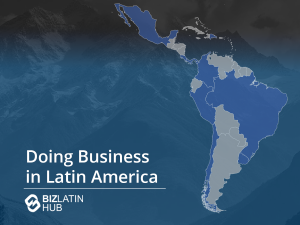Fundamental industries in the world’s economies are undergoing a revolution founded mainly on science, technology, and innovation (STI), and information and communication technologies (ICT).
Companies are a part of this revolution, continually exploring new ways to gain value by reducing costs, optimizing, and becoming more efficient. Governments’ and private firms’ growth strategies now include investment in new digital technologies leading to innovative business models.
But what about Colombia? Where does the country stand in terms of this revolution? It’s relevant to take a quick look at modernization in Latin America, with an emphasis on Colombia and its oil and gas industry.
We explore the government’s commitment to Colombia’s modernization and the impact that this effort may have on oil and gas activities.
Colombian Oil and Gas Opportunties – Discussion in three parts

This series, “Colombian Oil and Gas Companies amidst the Tech Revolution” is divided into 3 parts. In Part 1, we gave an overview of the oil and gas industry and its response to the impending tech revolution. We discussed some of the challenges the oil industry faces during this process, and the role technology could play in Colombia’s upstream, midstream, and downstream elements.
In Part 2, we lay out a general view of Latin America in the context of digitalization, and then narrow the scope to Colombia. We introduce key elements of the government’s National Development Plan that will drive technological change. This includes the Digital Transformation Pact, Science, Technology and Innovation Pact, and Mining and Energy Resources Pact.
In Part 3, we discuss how these pacts can benefit Colombia’s oil and gas industry and how it can contribute to overall social and economic growth and development.
Digitalization in Latin America
Latin America is not foreign to innovative change. Technology, digitalization, transformation, and start-up activities are now a part of Latin America’s vocabulary. Climate change, free carbon emissions, renewable energy, energy transition, are also a part of the region’s common language today, especially in the energy sector.
Latin American economies are seeing disruptive and revolutionary changes in their major, staple industries. Technology is infiltrating the most traditional of practices and commercial methods, transforming the way people do business and how they relate with communities. Competitive, tech-savvy arrivals in various service industries (such as finance) are also forcing governments to set a new tone for innovation and future development in their policymaking.
Technology intersects every industry and helps businesses and people achieve what was previously considered unachievable. Of course, the oil and gas industry is no exception, and welcomes innovation that can boost productivity and growth, front-facing challenges that are specific to this industry, including change and risk management.
Telecommunications infrastructure is one of the keys to the economic and social development of the twenty-first century. In the last 20 years, Latin America had significant advances in voice communications, mainly as a result of the development of mobile networks. Now, the region, like the rest of the world, aims to achieve universal access to data communications, which today means mainly access to the internet.
Colombia’s modernization agenda

Colombia decreased its poverty from 49.7% in 2002 to 27% in 2017, and its middle class has ballooned, increasing significantly since 2002. (16.3%). In 2017, this socioeconomic demographic had grown a whopping 31%.
Compared with the most developed countries in Latin America, Colombia has been behind in STI/ICT development.
For example, figures for Colombia on “patents granted to nationals on an annual average during the last ten years is 71, compared to 714 from Brazil, 281 from Mexico, 249 from Argentina or 129 from Chile. Colombia has 0.53 researchers per 1,000 economically active people, compared to a Latin American average of 1.69.”
Currently in Colombia, 50% of the population does not have access to the internet, and 38% do not use it. This lack of access is typically experienced by those in isolated and rural communities, further away from urban centers, and also due to the country’s complex geography that makes digital access difficult to many regions.
Tech and innovation challenges for Colombia
In the government’s view, there are several challenges to accelerating the country’s economic growth despite the swelling of its working demographic, namely:
- Halted productivity in the last decade
- Illegal economic activity
- Corruption
- Deep regional disparities, especially in rural areas
- Labor and business informality
- Tax and regulatory costs that discourage business
- Lags in the digital transformation of the country
- Economic vulnerability to disasters.
During his campaign, Colombia’s President Ivan Duque announced that he wanted to increase the country’s productivity and grow its economy by modernizing it. This includes sponsoring investments in digitalization and innovation in a range of economic areas for Colombia, which will reduce these obstacles as explained below.
National Development Plan
Colombia’s National Development Plan (PND) is a formal document outlining the government’s goals during a President’s term. The President develops appropriate policies with his team of experts and officials, and the PND establishes the strategic guidelines of those public policies. The country’s National Planning Department is responsible for its development, socialization, monitoring, and evaluation.
Pact for Colombia, Pact for Equity

This government’s PND known as the Plan Nacional de Desarrollo 2018-2022 Pacto por Colombia Pacto por la Equidad captures Duque’s campaign program, including government intent for supporting STI and ICT. It was issued by Congress on May 25, 2019, under Law 1955, 2019.
As its name says, the PND is a pact for equity. It seeks to obtain social and productive inclusion through two main pacts: entrepreneurship and legality.
The purpose of this PND is to stimulate targeted socioeconomic areas and enable the country to be more productive and develop equity, bringing about social change and sustainable growth. This strategic document is broken down into several targeted elements, and contains some key missions known as ‘pacts’ that will drive development in crucial areas.
The Entrepreneur Pact
The PND contains an ‘Entrepreneurship Pact’ which is based on 4 pillars: environment to grow, business transformation, a world to grow and the simple State.
The Entrepreneur Pact establishes measures that seek to increase entrepreneurship in Colombia, ease the creation of new companies, and increase labor numbers and business standardization. To achieve this pact, the government aims to promote the use of high-end technology by corporations, incentivizing innovation so Colombian companies can become more productive.
Bringing technology onboard
The plan suggests that to transform business productive development, innovation, and technological adoption are needed. This transformation can be achieved by strengthening the technical capacity of the companies. Once they search and learn, they can transfer technology for others to absorb. To this end, research and development (R&D) and the knowledge produced by universities, is of the highest importance.
Much of the country’s development, including science and innovation depend on royalties from the hydrocarbon sector. However, the plan explicitly states that the Entrepreneurship Pact will reduce the dependence on mining and hydrocarbons enhancing the opportunity to expand towards renewable energies and towards a digital economy. By migrating to economies based on added value service offers, creativity, and productivity in areas such as agriculture the reduction is possible.
The PND intersecting pacts recognize mining and hydrocarbon sectors as crucial for Colombia’s development and its economic growth so attention will focus on these.
Three Intersecting Pacts
The PND includes a series of intersecting pacts whose combined strategies intend to reactivate the economy, enhancing modern commercial policies geared towards productivity and competitivity for Colombian business.
The pacts that could apply to technology in the oil and gas industry in Colombia include:
- Science, Technology and Innovation Pact: developing a system to build knowledge in Colombia,
- Digital Transformation Pact: connecting government, companies, universities and homes with the knowledge era, and
- Mining and Energy Resources Pact: supporting sustainable growth and the expansion of opportunities.
A fourth pact that has an impact on all others, especially those mentioned above, is the Sustainability Pact.
The Sustainability Pact recognizes the need for economic growth and development, but also the need to reduce environmental impacts. That is where innovation and technology play a crucial role and where there is an opportunity for the oil industry to continue generating oil, royalties, and taxes for the country while becoming more sustainable.

There are several opportunities in the oil industry to reduce environmental impacts, through innovation and technology, and to become more sustainable. To name two:
- diminishing the sulfur content in fuels, to increase air quality
- decreasing greenhouse gases to contribute to reducing climate change.
The combined strategies of these intersecting pacts in the PND intend to reactivate the economy, enhancing modern commercial policies geared towards productivity and competitivity for Colombian business.
Positive outlook for oil and gas innovation
Each of these doctrines establishes the government’s objectives on the subject and how it intends to achieve them. For oil and gas, Colombia’s intent with the PND is to promote greater uptake of technology, increase joint opportunities to investigate and drive innovation and new business.
Moving into the market? Get in touch with us
The oil and gas industry in Colombia is being positioned for significant, innovative change. Colombia is working hard to present viable commercial opportunities for foreign investors and exploration businesses in the country’s key sectors. Don’t wait for others to claim this opportunity; acting now, amidst the establishment of strong growth objectives, could ensure your long term commercial success in Colombia.
When expanding to Colombia, keep in mind that while formation and operational requirements are complex, you’ve got expert support available to guide you through the commercial and corporate compliance procedures.
Our team at Biz Latin Hub wants what’s best for your business when moving into a new market. With our expert knowledge and local experience, we guarantee your company our full attention and the highest standard of legal, accounting, and employment services. Our customizable suite of market entry and back-office solutions will support your business needs and set you up for success.
Reach out to our friendly Colombia team here at Biz Latin Hub today for a personalized quote.




